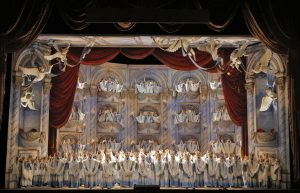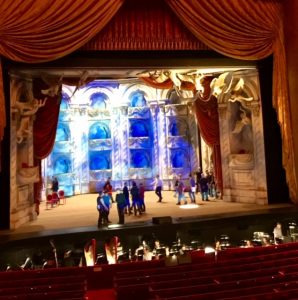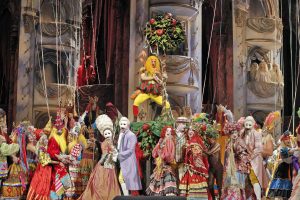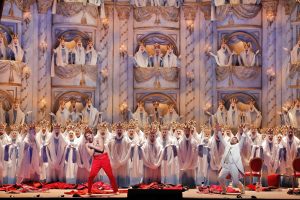An opera event coming up in New York is worth paying attention to. Over the next few weeks, the Metropolitan Opera is presenting eight performances of Arigo Boito’s Mefistofele (November 8 through December 1), and I was lucky enough to be invited to a working rehearsal on Thursday. I was pleased to spend a day watching the company put together what is, to me, one of the great classics of the operatic repertory.

(San Francisco Opera Photo)
There’s a reason why, and I expect it’s something separate from the opera itself. I had lived in New York for only one year when New York City Opera – which closed in 2013, after 70 wonderful years – produced what turned out to be, in my opinion, the definitive production of this great opera. I remember that it was a great success when it premiered in 1969. In the archives of WQXR (NYC’s local classical radio station), there is an article in which Amanda Angel asserts that NYCO’s Mefistofele was one of five NYCO productions that made opera history. Certainly I felt that way about the production, when I saw it in 1969 and many time after, as the opera became an incredibly popular mainstay of the NYCO repertory.
Sadly I cannot share any photos of that famous Tito Capobianco production of the NYCO Mefistofele, but they must exist (so far I’ve not been able to find any readily). It was an amazing show. Somewhat Byzantine in overall style, if I’m remembering correctly, with the phalanx of angels, cherubs, seraphs, and others of the “mystic choir” all depicted with golden halos and headpieces in the huge hanging backdrop, with the huge chorus singing behind the flat. Because there is so much choral music in the opera (one of the world’s great choral pieces, from this ex-chorister’s point of view), there is much for them to sing, and the music indeed lifts the opera goer to heights not often realized. Indeed, based I am sure on the choral music, Mefistofele has been referred to as “one of the most profound works for the lyric stage, one of the most beautiful scores that has come out of Italy.” I could not agree more.
It’s interesting that Mefistofele did not achieve popular success in its early days, but that lack of interest in no way diminished Boito’s talent. Still, he is far better known as a librettist than as a composer, especially for his work on Otello and Falstaff for his friend Verdi. And with such a distinguished score before us, we can now give a little more attention to the production. There’s a long history to what we have at the Met, and it’s a good story, giving us much background (the opera synopsis is at the Met’s own site: https://www.metopera.org/discover/synopses/mefistofele/).

The present production was first put together back in 1988 in Geneva by Robert Carsen. I was amazed to realize that this production is as old as it is, for it certainly did not look that old in the working rehearsal I visited last week. Much up-keep must have gone into the work over the years, and I suppose when a production is a favorite of many audiences (it’s now co-owned by the Metropolitan Opera and San Francisco Opera), it’s truly worth keeping in shape. I hope this one will be around for a long time.
Patrick Dillon in Opera News (March 2015) states what he sees as the secret of this production’s enduring success:
[Carsen] loves and respects Boito’s grand, tuneful, wittily literate opera. But it’s not a pious respect. He and his designer, Michael Levine – in the first of their many happy collaborations – set Mefistofele in an eighteenth-century opera house with century-spanning carryings-on; their here-and-now is the Italy of the Risorgimento, but their Walpurgis Night is an overage kiddies’ birthday party of the 1950s run amok, and the devil of the epilogue swigs from a bottle of (what else?) Johnnie Walker Red. Carsen’s wholehearted embrace of theatricality, with all its artifice – stage boxes, orchestra pit, ladders, flies, spots – is infectious: he never tries to fool you; he simply lets you in on the fun.

San Francisco Opera Photo
When the production came to the San Francisco Opera in September, 1989 (the same production we now have at the Met), John Rockwell from The New York Times went out to see Mefistofele. Rockwell’s review describes what’s on stage at the Met:
What Mr. Carsen and Mr. Levine have done is mix together imagery from Baroque opera houses and Roman Catholic churches, commedia dell’arte and the Venetian carnival, and poured in all manner of additional symbolism, including mixed-period costumes with a stress on the mid- to late-19th century, beggars and homeless persons and considerable real and simulated nudity.
The whole potpourri courts charges of mockery of the opera, stylistic confusion and cliche (the world as theater). Yet in almost every respect it works, triumphantly. The world-as-theater metaphor is appropriate here, and very nicely realized. The sets are often gorgeous. And the whole affair breathes a sensitivity to the music and to Boito’s intentions that is rare on the operatic stage with any style of production.
The final tableau can stand for the whole. A baroque opera theater as seen from the stage forms the set, boxes rising in tiers, with the chorus in white robes and Venetian masks and gold crowns holding twinkling candelabras, everything gauzy and white and rose petals fluttering down from on high. This struck some as campy and deliberately parodistic. It struck me as beautiful, and so intended by Mr. Carsen and Mr. Levine.

(San Francisco Opera Photo)
And another reviewer, Janos Gereben, reviewing the 2013 revival at the San Francisco Opera, wraps up all the discussion very neatly:
The chorus was heavenly in heaven both at the beginning [of the opera] and in the big Epilogue closing the work … [in] the Epilogue and with the chorus there, lifting both Faust and the audience to heaven. (Which, not so incidentally, in Carsen’s production, is an opera house. How true!)
There’s so much more, and I could go on and on writing about this wonderful opera, which I encourage all my friends and readers to experience. But at the same time, I’m having another thought, and I’m not sure I can put this together so that it makes sense, connecting something serious with something that – devised in the 19th century simply as musical entertainment – can lend itself to more serious meaning.
Perhaps there’s another way of looking at something like this Mefistofele, for while we’re happy to be entertained with all the music and the production and the “event” itself, couldn’t there be something a little deeper going on? After all, the story is simple. It’s nothing more than the triumph of good over evil, and despite all the vicissitudes of the telling, it is simply a story that can be good for us if we just give it some thought. Just how evil does evil have to be before some way – not necessarily a deus ex machina or some other manifestation of divine intervention – but some way is found to move away from the evil and move toward the good?
We hear a great deal these days about overcoming the so-called “evils of modern society,” and certainly in our current global picture we are facing very serious crises. Perhaps we all need to pause and think about what’s happening between good and evil in our lives, in our nation, and in the world as a whole. Even, perhaps, attending a performance of Mefistofele, just to think about – amidst all the production, the singing, the dancing, the overall effect – just to think about and try to cut through it all and give some attention to the message.
Will good triumph over evil?
Who knows? But for a stimulating and very enjoyable experience, go to the Met or listen to the performance on the radio at 1pm on Saturday, December 1, and see what kind of experience you have. It will be something you’ll like, I can assure you. And probably never forget.
Afterword (November 21, 2018). Having now seen “Mefistofele” at the opera house, I’m not about to take back any judgement thoughts I’ve shared above. Indeed, I agree with Zachary Woolfe in his review in The New York Times, where he is going along with much of the same line of thinking as John Rockwell writing about the production at San Francisco back in 1989 (and probably even some of the other reviewers I’ve quoted above):
The best that can be said for some recent Metropolitan Opera productions — “Samson et Dalila” and “Tosca,” I’m looking at you — is that they don’t actively hinder the works being performed. But Robert Carsen’s staging hardly ever stops helping Boito’s “Mefistofele,” which opened on Thursday in its first Met revival in almost 20 years.
Here is a lavishly flawed opera — a lush, static, lengthy musical layer cake — that achieves levity, and even demonic delight, through Mr. Carsen’s interventions. He turns Boito’s sequence of episodes from Goethe’s “Faust” into a louche, lively cross-chronological carnival: part Italian street theater, part bordello, part Baroque theater, part Catholic Mass. If this all doesn’t make “Mefistofele” quite succeed, it does make it dance.
Not surprisingly, as any reader can surmise from what I wrote back in early November and from my thoughts now, I’ve not changed my mind. “Mefistofele” is an amazing experience, all the way ’round, and it’s not often that we get this level of musical integrity, production strength, and just overall excellence in a performance. Thank you, all the folks at the Met who were involved in putting this together.
Leave a Reply